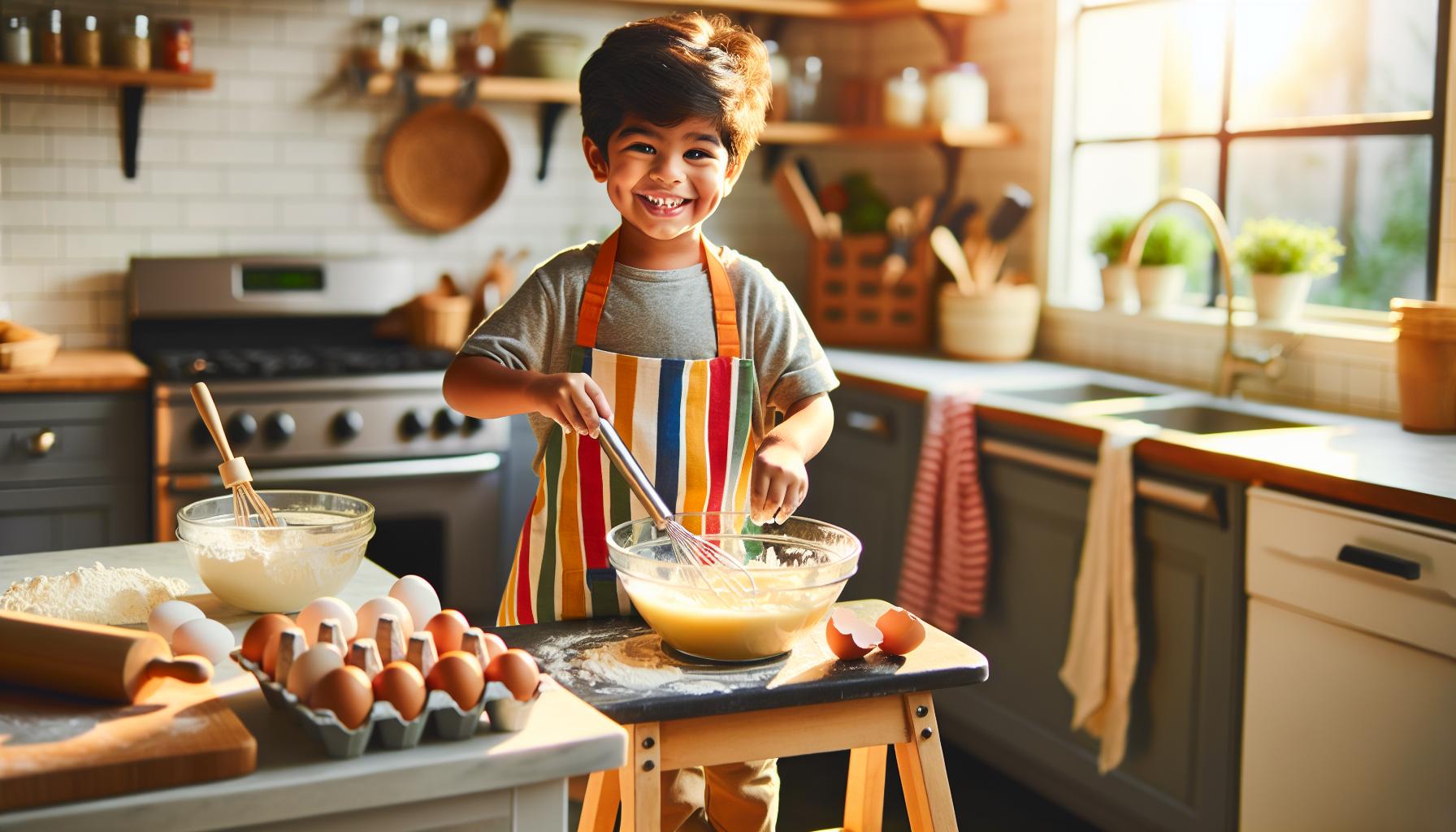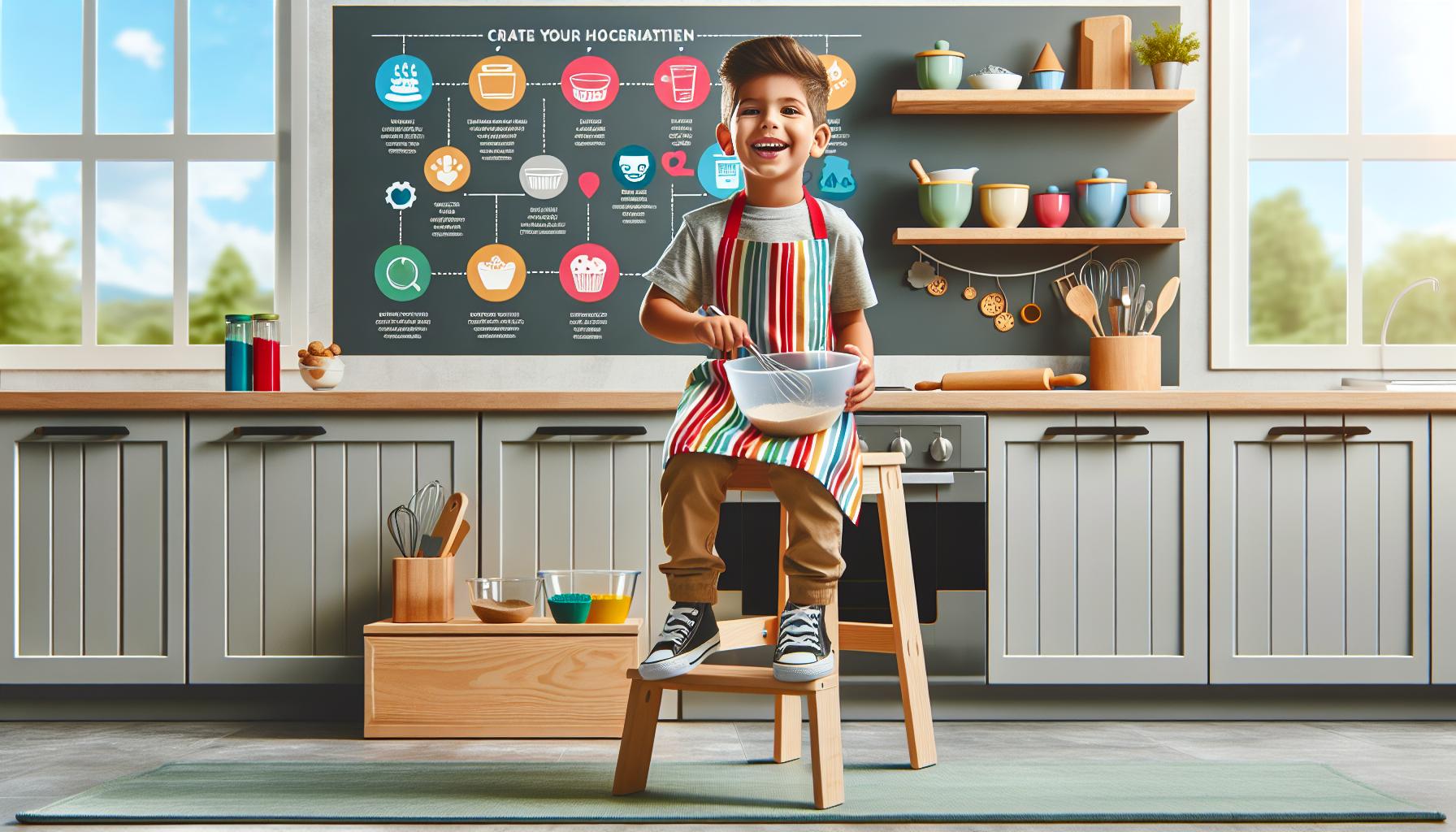
Baking with kids isn’t just about creating delicious treats – it’s a wonderful opportunity to build lasting memories and teach valuable life skills. We often find that young bakers learn best through hands-on experience in the kitchen, where they can practice following instructions while discovering the joy of creating something from scratch.
From measuring ingredients to decorating cookies, every step of the baking process offers children a chance to develop essential skills. They’ll learn kitchen safety, basic math concepts, and the importance of patience as they watch their creations come to life. What’s more exciting than seeing a child’s face light up when they pull their first batch of perfectly baked cookies from the oven?
Want to start baking with your little ones but not sure where to begin? With pre-measured ingredients and clear step-by-step instructions, you’ll find that introducing kids to baking can be both fun and mess-free. Plus, you’ll be amazed at how quickly they pick up new skills while having a blast in the kitchen.
Key Takeaways
- Baking with children offers valuable learning opportunities beyond cooking skills, including math concepts, science principles, and fine motor development
- Age-appropriate tasks and proper safety guidelines are essential – start with simple activities for younger children and gradually increase complexity as they gain experience
- Creating a kid-friendly kitchen environment with child-sized tools, designated work zones, and safety features helps ensure successful and safe baking experiences
- Simple recipes like no-bake treats and basic cookies provide perfect starting points for young bakers while building their confidence and skills
- Incorporating themed activities and educational elements makes baking more engaging while teaching practical life skills and scientific concepts
- Teaching proper cleanup routines and managing expectations around messes helps children develop responsibility and organizational skills
Benefits of Baking With Children
Baking activities with children create lasting memories while teaching essential life skills. The hands-on experience in the kitchen transforms simple recipes into valuable learning opportunities.
Building Confidence and Life Skills
Children gain confidence through completing baking tasks successfully. Small achievements like cracking eggs properly or measuring ingredients build self-esteem. Through baking, kids learn kitchen safety, time management, following instructions and working as part of a team. They practice making decisions about decorating treats and develop problem-solving abilities when recipes need adjustments.
Learning Math Through Measuring
Baking introduces mathematical concepts in a practical, engaging way. Kids practice addition, subtraction, fractions and measurements while portioning ingredients. Converting recipe quantities teaches multiplication and division skills. Reading recipe times and temperatures reinforces number recognition and basic math operations.
| Math Skill | Baking Application |
|---|---|
| Fractions | Measuring cups/spoons |
| Addition | Combining ingredients |
| Multiplication | Doubling recipes |
| Time | Tracking bake times |
Developing Fine Motor Skills
Baking activities strengthen children’s hand muscles and coordination through specific motions:
- Rolling dough develops palm strength
- Decorating cookies improves hand control
- Whisking ingredients builds arm muscles
- Pouring liquids enhances hand-eye coordination
- Cutting shapes refines precise movements
The repetitive actions in baking help children master essential fine motor abilities they’ll use throughout their lives. These skills transfer to other activities like writing, crafting and sports.
Essential Safety Guidelines

Safety comes first when baking with kids. Creating a secure environment establishes good habits that last a lifetime.
Kitchen Rules for Kids
Kids learn kitchen safety through clear boundaries and consistent reminders. Here are essential rules for young bakers:
- Wash hands thoroughly with soap before touching ingredients and after handling raw eggs
- Keep hair tied back and wear an apron to prevent contamination
- Walk slowly in the kitchen, avoiding running or horseplay
- Stay away from hot surfaces like ovens and stovetops
- Ask for help when using sharp tools or handling hot items
- Clean spills immediately to prevent slips and falls
- Keep electrical appliances away from water
- Never lick raw batter containing eggs
Age-Appropriate Tasks
Different ages require specific safety considerations and task assignments:
Ages 2-3:
- Wash fruits and vegetables
- Add pre-measured ingredients to bowls
- Stir room-temperature batters
- Sprinkle toppings
- Help with cleanup
Ages 4-5:
- Pour liquids into measuring cups
- Mix dry ingredients
- Knead dough
- Use cookie cutters
- Decorate cookies and cupcakes
Ages 6-7:
- Measure dry ingredients
- Crack eggs into separate bowls
- Roll out dough
- Grease pans
- Set timers
- Read recipes independently
- Use hand mixers
- Check oven temperatures
- Remove items from ovens with supervision
- Package finished goods
Each task matches a child’s developmental abilities, setting them up for success in the kitchen.
Setting Up Your Kid-Friendly Kitchen

Creating a welcoming kitchen environment sets the foundation for successful baking sessions with children. A well-organized space makes baking safer, more enjoyable and encourages independence in young chefs.
Must-Have Tools and Equipment
Kids need properly sized tools to participate effectively in baking activities. Here’s what to include in your child-friendly kitchen setup:
- Child-sized aprons with adjustable neck straps
- Plastic mixing bowls that resist slipping
- Silicone spatulas with shorter handles
- Measuring cups with large print numbers
- Clear plastic measuring spoons
- Non-slip mixing mats
- Cookie cutters with rounded edges
- Plastic cookie sheets for practice
- Step stools with rubber grips
- Child-safe whisks with cushioned handles
Creating a Safe Workspace
Safety features transform an adult kitchen into a child-friendly baking zone:
- Clear countertops of sharp objects knives electric appliances
- Establish designated “kid zones” away from the stove oven
- Install cabinet locks on drawers containing sharp tools
- Place frequently used ingredients at child height
- Add non-slip mats around work areas
- Position a stable step stool for proper counter height
- Create handwashing station with soap paper towels
- Keep cleaning supplies within adult-only reach
- Mark “off-limits” areas with colored tape
- Install outlet covers on unused electrical sockets
| Item | Location | Purpose |
|---|---|---|
| Kid tools | Lower drawers | Easy access |
| Dry ingredients | Mid-level shelves | Supervised reach |
| Decorating supplies | Clear containers | Visual organization |
| Safety equipment | Eye-level storage | Quick retrieval |
Easy Recipes to Start With
Starting with simple recipes creates confidence in young bakers while teaching fundamental kitchen skills. These beginner-friendly options offer quick success with minimal complexity.
No-Bake Treats
No-bake treats provide an ideal starting point for kids to practice kitchen skills without hot ovens. Children mix ingredients like graham crackers crushed cookies rice cereal with melted butter chocolate to create tasty desserts. Popular options include:
- Mix cereal bars using marshmallows butter
- Roll chocolate-dipped cookie balls
- Layer pudding parfaits with cookies cream
- Press fruit nut bars into pans
- Combine trail mix clusters with melted chocolate
Simple Cookie Projects
Cookie baking introduces children to measuring mixing shaping skills. Basic drop cookies require few ingredients minimal steps making them perfect for beginners. Key starter recipes include:
- Drop sugar cookies with 5 ingredients
- Rolled oatmeal cookies
- Three-ingredient peanut butter cookies
- Basic chocolate chip cookies
- Cut-out butter cookies
- Classic blueberry muffins
- Banana chocolate chip muffins
- Apple cinnamon muffins
- Carrot raisin muffins
- Double chocolate muffins
| Recipe Type | Prep Time | Number of Ingredients | Skill Level |
|---|---|---|---|
| No-Bake | 15-20 min | 4-6 | Beginner |
| Cookies | 20-30 min | 5-8 | Beginner-Intermediate |
| Muffins | 25-35 min | 7-10 | Intermediate |
Making the Experience Fun and Educational
Baking with young children combines entertainment with valuable learning opportunities. The kitchen transforms into an interactive classroom where kids develop essential skills through hands-on activities.
Themed Baking Activities
Themed baking sessions spark creativity and enhance engagement through specialized projects. Kids connect with seasonal treats during holidays or create character-inspired desserts for birthday celebrations. Interactive elements like decorating stations with sprinkles, food coloring or edible markers add excitement to the baking process. Educational games complement the baking experience:
- Counting games using measuring cups
- Color matching with frosting shades
- Shape identification through cookie cutters
- Pattern making with toppings
- Basic math through doubling recipes
Incorporating Science Lessons
The kitchen serves as a natural science lab where children observe chemical reactions and physical changes. Here’s how baking introduces scientific concepts:
- Mixing ingredients demonstrates chemical reactions
- Measuring teaches volume conversions
- Temperature changes show matter transformation
- Rising dough explains yeast activation
- Melting chocolate displays state changes
Key scientific principles in action:
| Concept | Baking Example | Learning Outcome |
|---|---|---|
| Chemical Reactions | Baking soda + acid | Creates bubbles/rise |
| Physical Changes | Melting butter | State transformation |
| Temperature Effects | Baking cookies | Heat causes browning |
| Dissolving | Sugar in liquids | Solution formation |
| Fermentation | Yeast in dough | Gas production |
Pre-measured ingredients allow kids to focus on observing these scientific processes while maintaining organized workstations. Clear instructions guide young bakers through each experiment-like step, creating connections between everyday cooking and basic science concepts.
Handling Kitchen Mishaps and Messes
Baking with children creates opportunities to teach valuable lessons about responsibility and cleanliness. These moments transform potential chaos into learning experiences that build lifelong habits.
Teaching Clean-Up Skills
Clean-up routines start before the baking begins by gathering cleaning supplies within easy reach. Kids learn organization by placing ingredients back in cabinets after use, wiping spills immediately, and keeping a designated space for dirty utensils. Here’s a practical cleanup system for young bakers:
- Set up a cleanup station with paper towels, sponges, and a safe cleaning spray
- Place a step stool near the sink for easy dishwashing access
- Use plastic containers to sort dirty utensils from clean ones
- Create a reward chart for completing cleanup tasks
- Practice “clean as you go” by wiping surfaces between steps
- Designate specific roles like “ingredient keeper” or “counter cleaner”
Managing Expectations
Kitchen messes offer perfect teaching moments for young bakers to develop resilience and problem-solving skills. Here’s how to set realistic expectations:
- Time Management
- Schedule extra time for cleanup during baking sessions
- Break tasks into 5-minute chunks for younger children
- Plan baking activities when there’s no rush to finish
- Mess Prevention
- Cover work surfaces with washable tablecloths
- Use deep mixing bowls to contain splatters
- Keep extra measuring cups handy for inevitable spills
- Positive Reinforcement
- Praise effort in cleanup as much as baking skills
- Take photos of their tidy workspace after cleanup
- Create cleanup games with simple rewards
- Celebrate small victories like spill-free measuring
Remember to keep supplies at child height and demonstrate proper cleaning techniques through example. This approach helps children understand that cleaning isn’t a punishment but an essential part of the baking process.
Conclusion
Baking with children is more than just creating delicious treats – it’s an invaluable opportunity to build lasting memories while developing essential life skills. We’ve seen how the kitchen can transform into a space where young minds flourish through hands-on learning experiences.
By investing time in baking with our little ones we’re not just teaching them about measurements and ingredients – we’re nurturing their confidence creativity and independence. The skills they gain in the kitchen from basic math to safety awareness will serve them well throughout their lives.
Let’s embrace the occasional mess and celebrate every small victory as our young bakers grow into confident kitchen helpers. After all the sweetest memories aren’t just about the treats we make but the precious moments we share while making them.
Frequently Asked Questions
What age is appropriate to start baking with kids?
Children can start participating in kitchen activities as early as 2-3 years old with simple tasks like washing fruits or stirring dry ingredients. As they grow, they can take on more complex tasks. By age 8-10, most kids can handle basic recipes with supervision.
How can baking help children learn math?
Baking naturally incorporates mathematical concepts through measuring ingredients, counting eggs, and working with fractions. Children learn addition, subtraction, and multiplication while doubling recipes or adjusting serving sizes. They also develop number recognition and estimation skills.
What are the best starter recipes for kids?
No-bake treats like cereal bars and chocolate-dipped cookie balls are ideal for beginners. Simple drop cookies, three-ingredient peanut butter cookies, and basic muffins are also great starting points. These recipes require minimal ingredients and basic techniques.
How can I make my kitchen child-friendly?
Create designated “kid zones” with child-sized tools and equipment. Use plastic mixing bowls, non-slip mats, and step stools. Keep sharp objects out of reach, install cabinet locks, and ensure countertops are at an appropriate height for children to work safely.
What safety rules should kids follow while baking?
Essential safety rules include washing hands before starting, keeping hair tied back, walking slowly in the kitchen, and avoiding hot surfaces. Children should also learn proper handling of kitchen tools and understand which tasks require adult supervision.
How do I handle kitchen messes when baking with kids?
Set up a cleanup station beforehand and schedule extra time for cleanup. Use deep mixing bowls to prevent spills, keep cleaning supplies accessible, and make cleanup fun with reward charts. Turn it into a learning experience about responsibility and cleanliness.
What life skills do children learn from baking?
Baking teaches patience, following instructions, problem-solving, and teamwork. Children develop fine motor skills, learn kitchen safety, and build confidence through completing tasks. They also gain practical experience with measurement, time management, and organization.
How can I make baking educational and fun?
Incorporate themed baking sessions, use cookie cutters for shape recognition, and count ingredients together. Explain basic science concepts through mixing and chemical reactions. Make it interactive with games and encourage creativity in decorating.

